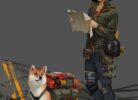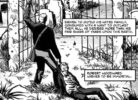I’ve already mentioned that I’m working on a dystopian science fiction novel. It will be, I hope, Philip K. Dick meets George Orwell thrust into a Stephen Spielberg film. That’s the aim, at least. I’ve had some rough nights where the words just don’t want to come (and those that do are crap), and other nights when things click and I’m at the edge of my seat, wondering what’s going to happen to our protagonists.
Wait, shouldn’t I know what’s going to happen to my characters? Well, yes and no. I’m writing with an outline, but it’s pretty loose. It’s a series of milestones the characters and/or plot must reach (though even those milestones can change in the course of the writing). A general roadmap without instructions on what roads to take. It’s enough to keep my destination in sight, while leaving open limitless possibilities on how to get there.
This approach is based on the overwhelmingly positive experience I had writing a middle grade fantasy novel last year. It kept my plot moving so briskly that I knew it was the right approach for this project. Prior to that, I had written a (terrible) fantasy novel based on a very strict outline. A to B to C to D. I knew well in advance what happened in each chapter, how it happened, and so on, right down to the letter.
It was boring. Both boring to write and boring to read.
Granted, I’m a much better writer now than I was then. I’d almost assuredly do a better job with that same story now. Yet it’s more than that. I left myself little room to explore the characters, world, and story. No room to be surprised at the turn a scene takes. No excitement of following a thread to see where it leads – excitement which (I hope) ends up on the page. Often, such turns can be far more natural and exciting than your meticulously crafted outline. After all, when you’ve hammered out that outline, you weren’t yet living with these characters.
And you don’t really know your characters until you’ve allowed them to live and breath on the written page.
Mind you, I do not endorse writing by the seat of your pants. It’s a surefire way to reach dead ends and stall out before your work is finished, or worse still, meander to a lame and unsatisfying finish. Making it up as you go along is fine for serialized fiction with no definitive end, such as monthly comic books, but if you’re writing a novel it needs to go somewhere. It needs a destination. An endpoint.
So I made a rough roadmap. I know where this story needs to go, but I’m allowing myself room to jump off an exit if the car wants to go that way. For instance, last night my characters found themselves stumbling across a haven I did not know existed. Where did it come from? I have no idea. But there it was. This completely threw off the confrontation and rescue I thought I was about to write, but that’s fine. Now there is this new and interesting element to explore. The confrontation and rescue will still take place, but in a different way and in a different setting.
I didn’t expect this turn of events, but that’s okay. In fact, it’s pretty damn exciting. I think it will make for a better story.
And at the end of the day, isn’t making your story the best story possible exactly what it’s all about?






